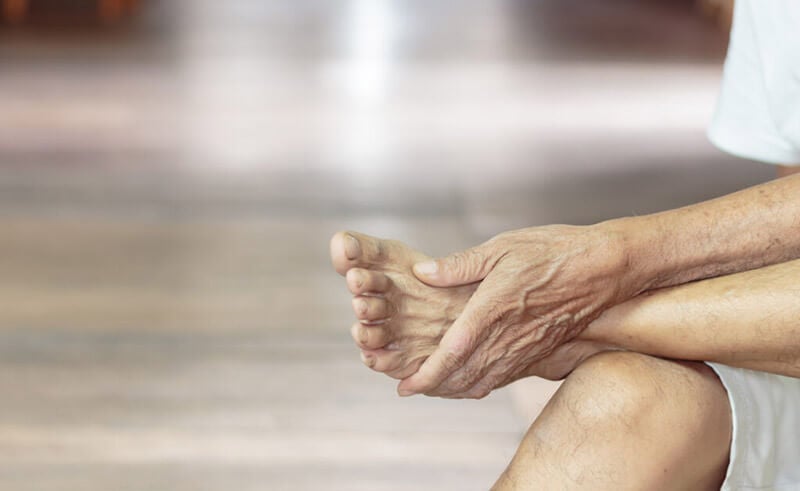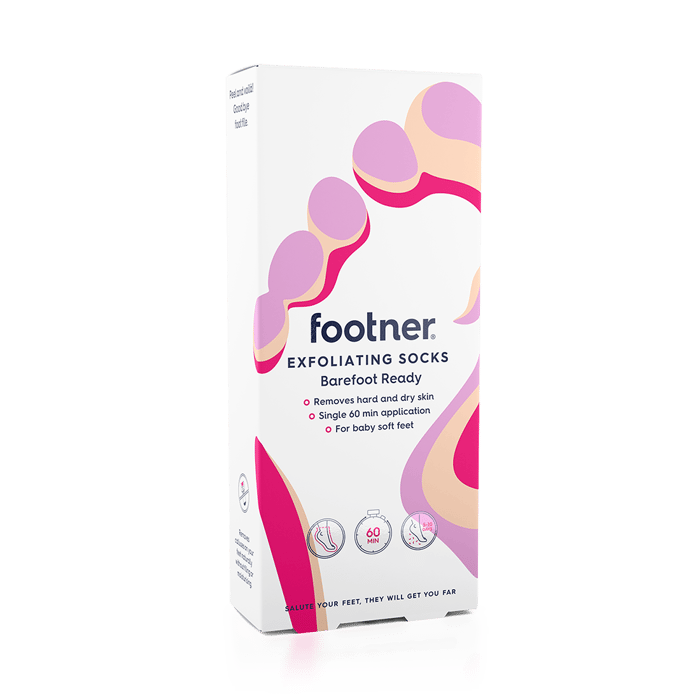Dry Skin on Feet
Having rough, dry, or dead skin on your feet is a very common issue. Although rarely a serious condition, it can be unsightly and cause discomfort, pain, or irritation if you don’t take action to remove dry skin from the feet. The good news is that in the vast majority of cases, it’s easy to get rid of dry skin on your feet with simple home remedies. Likewise, practising good foot care enables you to prevent dry and dead skin from building up in the first place.
This article goes into more detail about the causes of dry skin on top of toes and other parts of the foot, plus some of the symptoms to look out for. It also covers treatment options and home remedies to remove dry skin from feet, as well as foot care tips for preventing the problem from arising.
Causes of dry skin on feet
Although it’s possible to suffer from dry skin anywhere on your body, the feet are a particularly commonplace for the issue to occur. This is partly because the feet have fewer oil glands than other parts of the body – particularly the heels and soles – which means they don’t get as much natural hydration.
In addition, because we put weight and pressure on our feet every time we stand up, walk around, or do other such activities, they experience a lot of daily wear and tear. All of which means it’s no wonder we need to think about how to remove dry skin from feet!
There are a multitude of factors that can make it more likely you will develop dry skin on your feet. Some of the most common are given below.
Lifestyle factors contributing to dry skin on feet
Certain habits and actions can increase your risk of needing to remove dry skin from your feet. These include:
- Spending a lot of time on your feet, for instance, standing in one position for prolonged periods of time or walking a lot
- Using soaps with harsh chemicals that can strip moisture from your skin
- Not taking good care of your feet (e.g., not washing or drying them carefully)
- Not exfoliating or moisturising your feet
- Wearing shoes that don’t fit you well. For instance, narrow shoes that rub against your toes might result in dry skin on the toe knuckle or the sides of your foot
- Walking around outside barefoot encourages the skin on the sole of your foot to thicken as a protective measure
- Always wearing socks and shoes when you’re inside can draw moisture from the skin and dry it out
- Showering or bathing in very hot water
- Eating a poor diet that results in vitamin deficiencies
- Not drinking enough water and becoming dehydrated
Environmental causes of dry skin on feet
There are some environmental factors that make it more likely you’ll develop dry skin on your feet. For example:
- In very hot weather, the inside of your shoes can heat up and cause a loss of moisture from the skin of your feet
- In cold and dry weather, it’s easy for the skin everywhere on your body to dry out, resulting in peeling skin on hands and feet
Medical reasons for dry skin on feet
Some types of skin conditions and other medical concerns can increase your risk of suffering from dry skin on your feet. These include:
- Diabetes (which can damage nerves and reduce blood flow)
- Athlete’s foot and other fungal infections
- Eczema
- Psoriasis
- Hypothyroidism
- Certain allergies can cause skin rashes
- Some medications may cause dry skin as a side effect
Lastly, the simple fact of getting older can make it more likely that you’ll develop dry skin on your feet. This is because collagen production decreases, and cells are replaced more slowly as you age.

Symptoms suggest you should remove dry skin from feet
There are a number of symptoms that indicate you have dry skin on your feet and may want to use a foot dry skin remover. It’s possible to have dry skin on top of the foot, on the heels, the soles, and even dry skin around toenails, so check your feet thoroughly.
Some of the most common signs to look out for are:
- Dry or cracked skin
- Flaky or peeling skin
- Scaly skin
- Skin that feels rough to the touch
- Swelling
- Redness
- Itching
- Fissures in the heel, which may bleed
- A feeling of tightness
- Discolouration of the skin, giving it a white, yellow, or brown appearance
You may experience many of these symptoms or just a few of them, and they can range in severity from mild to serious. Similarly, you may only notice them in one spot, such as dry skin on the big toe knuckle or across the whole of your foot.
If your symptoms are severe, it can leave your feet vulnerable to infection, so watch out for warmth, redness, pus, and swelling in the area.
Treatments to remove dry skin from feet
Although having dry skin on your feet can be unsightly, in the vast majority of cases, it is nothing serious and can be easily treated. However, if you have an underlying health condition such as diabetes, then you should seek advice from a doctor before attempting to get rid of dry skin on your feet yourself.
Treat dry skin from feet at home
There are plenty of at-home methods you can use to get rid of dry skin on feet. Some of the most effective include:
- Using Footner exfoliating socks to peel away old, hard, dry, or dead skin
- Soaking your feet in warm water to soften the skin, then using a foot dry skin remover such as a pumice stone to gently remove hard and dry skin
- Using highly moisturising heel balms and lotions to rub into dry skin on top of the big toe and the rest of the foot
- Trying an Epsom salt soak or foot scrub
Medical treatment to remove dry skin from feet
In some instances, it might be necessary to seek medical treatment to get rid of dry skin on feet. This might be because your symptoms are particularly severe, the dry skin is being caused by another skin condition that needs treating, or you have an underlying health condition such as diabetes that impacts what foot treatments are suitable for you.
Possible medical treatment to remove dry skin from feet includes:
- Anti-fungal medication to treat conditions such as athlete’s foot
- Antibiotics to treat an infection
- Painkillers to manage your symptoms as they heal
- Extra strong creams and lotions to treat skin conditions such as eczema or soften very hard skin
- Removal of particularly hard and thick dead skin on the feet
Preventing dry skin on feet
It is usually possible to prevent dry skin from developing, so you won’t need to worry about how to remove dry skin from feet. The following top tips can help you to keep your feet happy, healthy, and hydrated:
- Clean your feet thoroughly on a regular basis
- When drying your feet, pat them gently with the towel rather than rubbing the skin vigorously
- Use products such as Footner exfoliating socks regularly to remove any hard or dead skin
- Moisturise your feet daily
- Bathe in warm water rather than hot
- Wear shoes that are comfortable, supportive, and fit you properly
- Don’t walk around outside barefoot
- Don’t use products that contain a lot of harsh chemicals on your feet
- Wear socks made from soft, moisture-wicking, and breathable fabric
- Eat a healthy diet and drink 6 to 8 glasses of water a day
Dry Skin on Feet FAQs
How to treat dry skin?
The best way to deal with dry skin is by keeping it moisturised. Use a rich heel balm or foot lotion every day, and put socks on afterwards to keep the product in place. It’s also helpful to use a foot dry skin remover such as Footner exfoliating socks regularly to keep your skin soft and smooth.
How to remove dead skin from feet?
If you have a buildup of hard dead skin on your feet, you’ll probably need to soften and then gently remove it. You can do this by soaking your feet in warm water and then using a pumice stone, heel scraper, or another type of foot dry skin remover. Alternatively, slip on a pair of Footner exfoliating socks and let them do the hard work for you!
When should I see a doctor to remove dry skin from feet?
In most cases, there is no need to see a doctor in order to get rid of dry skin on feet. However, if any of the following apply to you, then you should seek professional medical advice. If you think your feet are infected or your symptoms are not improving after a week or so of using home foot dry skin remover treatments, feet, get in touch with your doctor. Also, reach out if you have another skin condition, such as eczema or athlete’s foot, that is causing your dry skin, or you have diabetes or another underlying medical condition that impacts the health of your
What to do with dry skin?
If you have dry skin, you will want to make some changes to your lifestyle and seek out products to help combat the dryness. Footner exfoliating socks would help with dry feet, while other moisturisers, allergen-free soap, and using warm water will all help with other areas of dry skin on the body.


